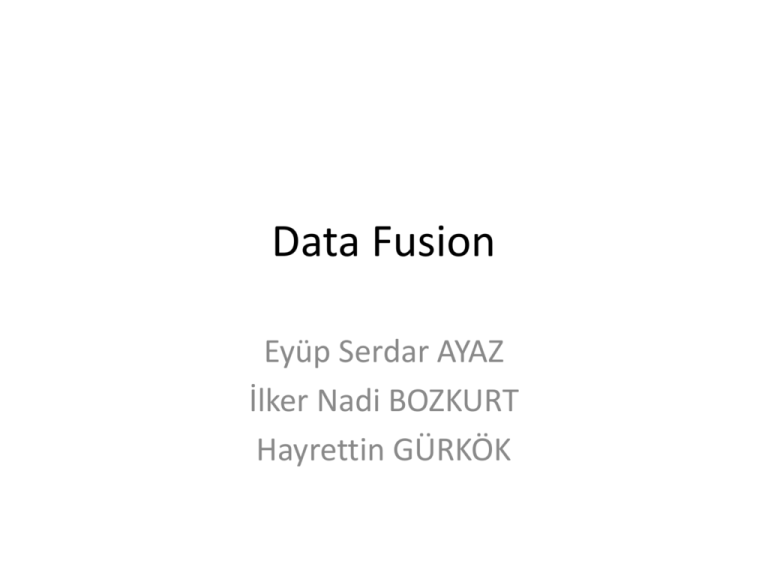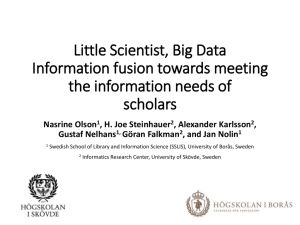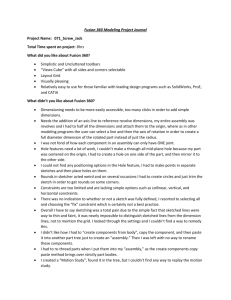Data fusion
advertisement

Data Fusion
Eyüp Serdar AYAZ
İlker Nadi BOZKURT
Hayrettin GÜRKÖK
Outline
•
•
•
•
What is data fusion?
Why use data fusion?
Previous work
Components of data fusion
– System selection
– Bias concept
– Data fusion methods
• Experiments
• Conclusion
2
Data Fusion
• Merging the retrieval results of multiple
systems.
• A data fusion algorithm accepts two or more
ranked lists and merges these lists into a single
ranked list with the aim of providing better
effectiveness than all systems used for data
fusion.
3
Why use data fusion?
• Combining evidence from different
systems leads to performance
improvement
– Use data fusion to achieve better
performance than the individual
systems involved in the process.
• Example metasearch systems
– www.dogpile.com
– www.copernic.com
4
Why use data fusion?
• Same idea is also used for different query
representations
– Fuse the results of different query
representations for the same request and
obtain better results
• Measuring relative performance of IR systems
such as web search engines is essential
– Use data fusion for finding pseudo relevant
documents and use these for automatic
ranking of retrieval systems
5
Previous work
• Borda Count method in IR
– Models for Metasearch, Aslam & Montague, ‘01
• Random Selection, Soboroff et.al., ‘01
• Condorcet method in IR
– Condorcet Fusion in Information Retrieval, Aslam &
Montague, ’02
• Reference Count method for automatic
ranking, Wu & Crestani, ‘02
6
Previous work
• Logistic Regression and SVM model
– Learning a ranking from Pairwise
preferences, Carterette & Petkova, ’06
• Fusion in automatic ranking of IR systems
– Automatic ranking of information retrieval
systems using data fusion, Nuray & Can ’06
7
Components of data fusion
1. DB/search engine selector
Select systems to fuse
2. Query dispatcher
Submit queries to selected search engines
3. Document selector
Select documents to fuse
4. Result merger
Merge selected document results
8
Ranking retrieval systems
9
System selection methods
1. Best: certain percentage of top performing
systems used
2. Normal: all systems to be ranked are used
3. Bias: certain percentage of systems that
behave differently from the norm (majority
of all systems) are used
10
More on bias concept
• A system is defined to be biased if its query
responses are different from the norm, i.e.,
the majority of the documents returned by all
systems.
• Biased systems improve data fusion
– Eliminate ordinary systems from fusion
– Better discrimination among documents and
systems
11
Calculating bias of a system
• Similarity value
s(v, w)
v w
(v ) ( w )
i
i
2
i
2
v: vector of norm
w: vector of retrieval system
i
• Bias of a system
B(v, w) 1 s(v, w)
12
Example of calculating bias
2 systems: A and B
7 documents: a, b, c, d, e, f, g
ith row is the result for ith query
XA=(3, 3, 3, 2, 1, 0, 0)
XB=(0, 2, 3, 0, 2, 3, 2)
norm vector X = XA+XB = (3, 5, 6, 2, 3, 3, 2)
s(XA,X)=49/[32][96]1/2 = 0.8841
Bias(A)=1-0.8841=0.1159
s(XB,X)=47/[30][96]1/2 = 0.8758
Bias(B)=1-0.8758=0.1242
13
Bias calculation with order
Order is important because users usually just look
at the documents of higher rank.
2 systems: A and B
7 documents: a, b, c, d, e, f, g
ith row is the result for ith query
Increment the frequency count of a document by m/i instead of 1
where m is number of positions and i position of the document.
m=4
XA=(10, 8, 4, 2, 1, 0, 0); XB=(0, 8, 22/3, 0, 2, 8/3, 7/3)
Bias(A)=0.0087; Bias(B)=0.1226
14
Data fusion methods
1. Similarity value models
– CombMIN, CombMAX, CombMED,
– CombSUM, CombANZ, CombMNZ
2. Rank based models
–
–
–
–
Rank position (reciprocal rank) method
Borda count method
Condorcet method
Logistic regression model
15
Similarity value methods
•
•
•
•
•
•
CombMIN – choose min of similarity values
CombMAX – choose max of similarity values
CombMED – take median of similarity values
CombSUM – sum of similarity values
CombANZ - CombSUM / # non-zero similarity values
CombMNZ - CombSUM * # non-zero similarity values
16
Rank position method
• Merge documents using only rank positions
• Rank score of document i (j: system index)
1
r (d i )
j 1 pos(dij )
• If a system j has not ranked document i at all,
skip it.
17
Rank position example
• 4 systems: A, B, C, D
documents: a, b, c, d, e, f, g
• Query results:
A={a,b,c,d}, B={a,d,b,e},
C={c,a,f,e}, D={b,g,e,f}
• r(a)=1/(1+1+1/2)=0.4
r(b)=1/(1/2+1/3+1)=0.52
• Final ranking of documents:
(most relev) a > b > c > d > e > f > g (least relev)
18
Borda Count method
• Based on democratic election strategies.
• The highest ranked document in a system gets
n Borda points and each subsequent gets one
point less where n is the number of total
retrieved documents by all systems.
19
Borda Count example
• 3 systems: A, B, C
• Query results:
A={a,c,b,d}, B={b,c,a,e}, C={c,a,b,e}
– 5 distinct docs retrieved: a, b, c, d, e. So, n=5.
• BC(a)=BCA(a)+BCB(a)+BCC(a)=5+3+4=12
BC(b)=BCA(b)+BCB(b)+BCC(b)=3+5+3=11
• Final ranking of documents:
(most relevant) c > a > b > e > d (least relevant)
20
Condorcet method
• Also, based on democratic election strategies.
• Majoritarian method
– The winner is the document which beats each of
the other documents in a pair wise comparison.
21
Condorcet example
• 3 candidate documents: a, b, c
5 systems: A, B, C, D, E
• A: a>b>c - B:a>c>b - C:a>b=c - D:b>a - E:c>a
Pairwise comparison
Pairwise winners
Win
Lose
Tie
a
2
0
0
2, 2, 1
b
0
1
1
-
c
0
1
1
a
b
c
a
-
4, 1, 0
4, 1, 0
b
1, 4, 0
-
c
1, 4, 0
2, 2, 1
• Final ranking of documents
a>b=c
22
Experiments
• Turkish Text Retrieval System will be used
– All Milliyet articles from 2001 to 2005
– 80 different system ranked results
• 8 matching methods
• 10 stemming functions
– 72 queries for each system
• 4 approaches for on the experiments
23
Experiments
• First Approach
– Mean average precision values of merged system
is significantly greater than al the individual
systems
• Second Approach
– Find the data fusion method that gives the highest
mean average precision value
24
Experiments
• Third Approach
– Find the best stemming method in terms of mean
average precision values
• Fourth Approach
– See the effect of system selection methods
25
Conclusion
• Data Fusion is an active research area
• We will use several data fusion techniques on
the now famous Milliyet database and
compare their relative merits
• We will also use TREC data for testing if
possible
• We will hopefully find some novel approaches
in addition to existing methods
26
References
• Automatic Ranking of Retrieval Systems using
Data Fusion (Nuray,R & Can,F, IPM 2006)
• Fusion of Effective Retrieval Strategies in the
same Information Retrieval System (Beitzel
et.al., JASIST 2004)
• Learning a Ranking from Pairwise Preferences
(Carterette et.al., SIGIR 2006)
27
Thanks for your patience.
Questions?
28





